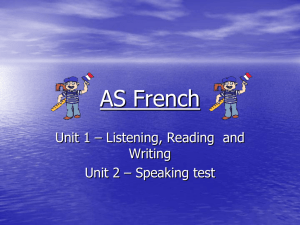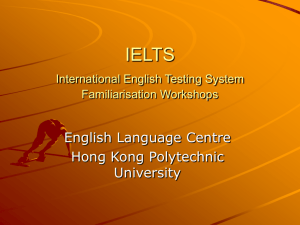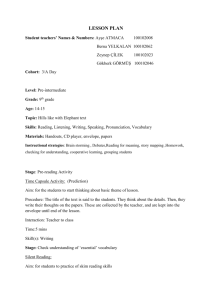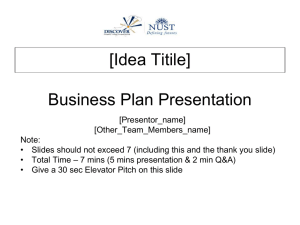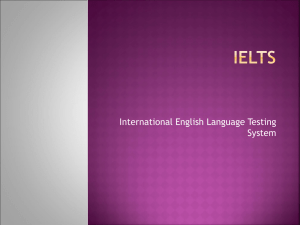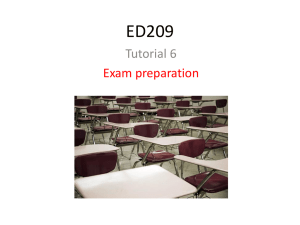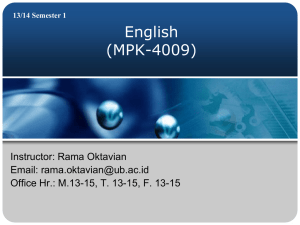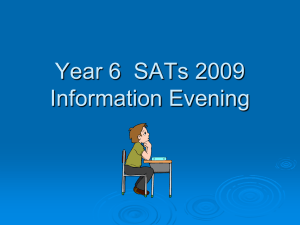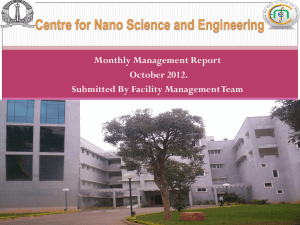IELTS overview
advertisement
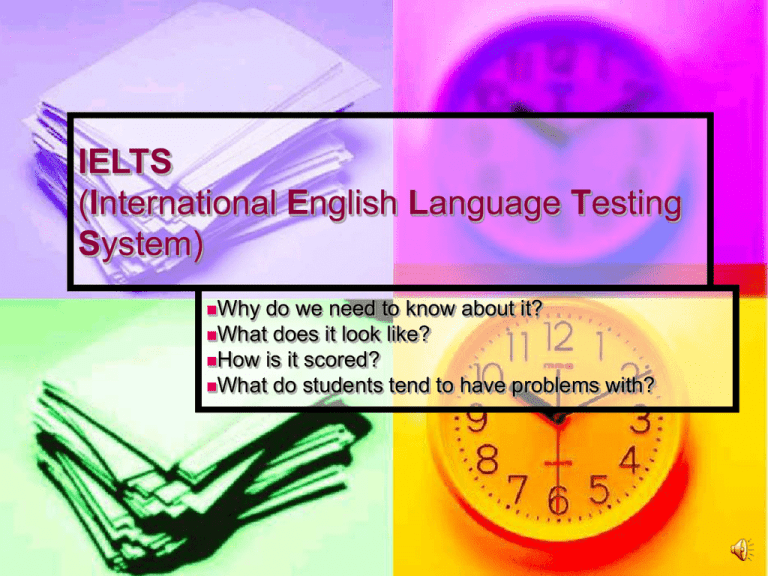
IELTS (International English Language Testing System) Why do we need to know about it? What does it look like? How is it scored? What do students tend to have problems with? Why do we need to know about it? PSU accepts the IELTS for admission Undergraduate score: 6.5 with 6.0 in each band Graduate score 7.0: overall (no minimum band score needed!) More about scoring A score is reported for each test component. The individual test scores are then averaged and rounded to produce an Overall Band Score. Overall Band Scores and individual test scores are reported in whole and half bands. Another reason we need to know about it More and more of our students are taking it! What does the whole test look like? IELTS is available in two formats – Academic and General Training. Our students must take the Academic version. Each format has 4 tests, one in each of the skills. All test takers (in both the Academic and General Training tests) take the same Listening and Speaking tests. The Writing and Reading tests are different. The first 3 tests (Listening, Reading, and Writing) must be taken the same day. The Speaking test can be taken 7 days before or after (depending on the testing center). There is no break between the tests. Academic Format Test Components and Times 1. 2. 3. 4. Listening – 40 mins Academic Reading – 60 mins Academic Writing – 60 mins Speaking – 11 – 14 mins __________ ~ 2 hr. 45 mins What does each test look like? 1st Test (40 minutes) Listening Listening Candidates listen to 4 recorded texts – 2 conversations and 2 monologues. These feature a variety of English accents. The recording is heard only once. Candidates are given time to read the questions before each text starts. Listening cont. They write down their answers in the test booklet while they are listening. At the end of each section, they have 30 seconds to check their answers. At the end of the test, they are given 10 minutes to transfer their answers to the official answer sheet. Poor spelling and grammar are penalized. Writing more than is necessary is penalized. Listening Test Question types: multiple choice short-answer questions sentence completion note/summary/flow-chart/table completion labeling a diagram classification matching Listening Section Sample Audio Tapescript for audio Questions for audio Listening – Common Challenges Each recording played only once. Must write and listen simultaneously. Range of accents used. Must follow line of argument or thought. Unfamiliar vocabulary. Correct spelling required. 2nd Test (60 minutes) Reading Academic Reading There are three reading passages with a total of 2000 – 2750 words. Texts are taken from books, magazines, journals and newspapers, all written for a non-specialist audience. At least one of the texts contains a detailed argument. Academic Reading cont. Total of 40 questions 3 Categories of 10 Question Types: Matching Gap fill Selection Reading Section Sample Reading A with questions Reading A Answer Key Reading B with questions Readng B Answer Key Reading Common Challenges Time is short! Unfamiliar topics Unusual question types, such as labeling a flowchart Incorrect spelling and grammar are penalized. Writing more than is necessary is penalized. 3rd Test (60 mins) Writing Academic Writing 2 Tasks Candidates ADVISED 20 mins for 1st task, 40 mins for 2nd task Score based on: Task achievement Coherence and cohesion Lexical resource Grammatical range and accuracy Writing – 1st task Write a description of at least 150 words. Based on material found in a chart, table, graph or diagram Demonstrates ability to present information and to summarize the main features of the input. Writing Task 1 Organization Introductory Sentence(s) – describe the information presented in the graph…. General Observations Specific Observations Concluding Statement – analysis of information garnered from the visual Writing Task 1 Sample Rubric Task 1) Student Writing • Score and Comments Student Writing 2) • Score and Comments Student Writing 3) • Score and Comments Writing – 2nd task Write a short essay of at least 250 words in response to a statement or question. Demonstrate an ability to present a position, construct an argument and discuss abstract issues. Writing Task 2 Sample Rubric Task 1) Student Writing • Score and Comments Student Writing 2) • Score and Comments Writing – Common Challenges Task 1 Analyze, select, and order data See general trends Identify key chunks of information and exceptions to general trends Use complex sentence structure Task 2 Unfamiliar topic Take a stand and argue it effectively th 4 (and final) Test (11-14 minutes) Speaking Speaking The test is a face-to-face interview. Candidates are assessed on their use of spoken English to answer short questions speak at length on a familiar topic interact with the examiner Speaking Test Sections 1. Introduction and interview (4-5 mins) 2. Individual long turn (3-4 mins) 3. Give name and talk about self, family, and own life. Given a card prompt. 1 min to prepare 1-2 mins talk 1 min answer related question from examiner Two-way discussion (4-5 mins) Related to topic on the card Less personal Speaking Section Rubric Video of Interview – 1st section Video of Interview – 2nd section Score and comments Score and comments Video of Interview – 3rd section Score and comments Speaking – Common Challenges Talking extensively Vocabulary Abstract topics in 3rd section Online Resources http://www.ielts.org/ Handbook, sample tasks, tips, etc. http://www.worldenglish.org/ielts_free_tests.htm Free sample tests http://www.ielts-exam.net/ Info about the test and sample questions http://www.goodluckielts.com/index.htm Info, tips, samples, etc. http://nces.ed.gov/nceskids/createagraph/ Online graph maker The End
